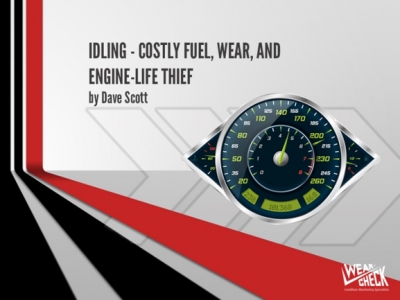Excessive idling is one of the most counter-productive facets of running a fleet of vehicles. In this Technical Bulletin, trucking expert Dave Scott discusses the effects of excessive idling and how to avoid it to minimise the negative consequences.
The costs
Let’s grab attention up front by following the money. Too many fleet owners cannot calculate the immediate cost of excessive engine idling – it can be massive when applying the following formula:
- Engine idling fuel consumption in litres/hour = 10% of engine displacement at 650rpm.
- An 8000cc truck diesel engine consumes 0,8 litres per hour idling at 650rpm – switch this up to 1000rpm and idling fuel consumption will double.
- The fleet multiplier effect is horrendous – a 50 vehicle fleet equipped with 8000cc engines can consume 40 litres idling diesel every day and in a 250-day working year this totals 10 thousand litres of lost fuel or R200,000 per annum at R20 per litre for only one hour per day.
And then there are the long-term costs…these are more difficult to quantify, but are there:
- Accelerated engine wear - An engine running at idling speed causes twice the wear on internal parts compared to driving at regular speeds. According to the American Trucking Association, such wear can increase maintenance costs by almost $2,000 per year and shorten the life of the engine. Additional press reports indicate that running a vehicle at idle speed dramatically reduces engine life - 60 minutes of idling is equivalent to between 80 and 120 minutes of driving time.
- More frequent engine oil changes – this to counter the effect of idling on engine oil. Incomplete combustion occurs when idling unnecessarily, resulting in over-fuelling. Combustion gases and fuel can enter the crankcase under these conditions, causing deterioration to the oil additive package, and eventually premature engine damage. An OEM (Original Equipment Manufacturer) benchmark is that where idle time is 20% and more, for service intervals to be reduced from 40,000km down to 30,000km
- The costs of global pollution and environmental damage – one wasted litre of combusted diesel fuel throws 2,64kg CO2 into the atmosphere. This is not confined to diesel fuel – petrol engines run at 2,30kg CO2. Now apply the estimated global internal combustion engine population of 1,4 billion motor vehicles and one hour of wasted fuel is disastrous – witness the daily economic effects of climate change.
- Health Risks to Drivers - While sitting in an idling vehicle there is no air flow to vent the emissions. Drivers are exposed to vehicle pollution more so than when the vehicle is in motion.
The myths
Here are the most common false ideas:
Wrong #1 – It is better to operate an engine in idle than frequently switch off and on.
The key word here is ‘frequent’ – in most cases modern truck engine software allows for a three-minute idle before automatic cut-off. Idling must not be left to driver discretion which could be anything from 10 – 30 minutes. The time limit for idling must be in a written driver SOP (standard operating procedure). Many modern passenger vehicles are equipped with idle auto cut-off.
Wrong #2 – Prior to moving loaded vehicles or those without load, idling is essential to warm up the engine before placing the engine under load.
Engines are equipped with coolant thermostats and lubricant/coolant heat exchangers to rapidly reach their operating temperature that is monitored by strategically placed sensors. Simply drive off without excessive over-revving.
Wrong #3 – Idling is good for an engine as there will not be any load on the engine.
Exactly the opposite occurs. Cylinders are designed to operate hot in a diesel engine and to maintain adequate temperature to completely burn injected fuel. During idling, accompanied by low reciprocating piston speed, the compression inside a cylinder will not be as effective as during high piston speeds. Thus, temperatures generated inside the combustion chamber do not attain the optimum level.
A few harsh facts
- Excessive idling means that piston rings do not expand adequately, causing insufficient sealing between piston ring and liners which leads to leakage of compressed gases.
- There is incomplete burning of injected fuel, leaving unburnt fuel in the combustion chamber, and passing the unburnt fuel to the engine sump through the gap between piston ring and liners.
- When fuel starts passing through the gap between the piston ring and the cylinder walls, the fuel washes the piston rings and cylinder liners and dilutes the lubricating oil. This action gradually develops a glazing/shining surface on the liners, eroding the crosshatch marks provided for lubricating oil retention.
- Glazing not only loses oil retention in liners but also slowly erodes the oil film which leads to accelerated wear of piston rings and loss of compression. This further increases the gap between the liner and the rings, causing severe leakage of compressed gases into the crank case, and leading to excess blow-by.
- Excess blow-by means loss of compression pressure, and loss of power and time to overhaul the engine. Further continuation of running with the same status leads to throwing lube oil through exhaust gases (lube oil passing into the combustion chamber through the increased gap between liner and rings).
- Improper burning or poor compression leads to excess carbon formation in piston rings grooves, piston crown, ring band, cylinder head, valves, injector tips etc.
- Excess carbon formation leads to sticking of piston rings in grooves, leakage of gases between valve and valve seats, improper fuel spray due to blocked injector spray holes and ultimately aggravating all issues mentioned above and loss of power.
- Diesel dilution in an engine causes a drop in lube oil viscosity and washing out bearing surfaces, dropping lube oil pressure, killing oil film, and making metal to metal contact of moving parts. Ultimately, a faster wear of bearings and journals occurs, and premature engine overhaul is necessary.
- Diesel mixing with lube oil also leads to faster wear of lube oil pump components and reducing pump efficiency. Lower oil pressures at idle are only going to add to accelerated wear issues.
- Fuel spiking with uncertified biodiesel mixtures and illuminating paraffin has a distinct impact on diesel lubricity which will only magnify idling problems.
The countermeasures
In the USA, legislation has already been introduced to curtail excessive idling – enforcement is the challenge. It’s very doubtful this will ever come to Africa as we struggle to apply even the basic traffic safety laws.
But don’t rely on Governments and legislation – there are actions that can be taken by large fleets and private motorists.
- Training and mentoring drivers is priority #1 – in any corporate body with a vehicle fleet there is much ignorance around idling and possible solutions to reduce time spent idling. Coaching must be consistent and not just a seasonal fad. Standard operating procedures for engine idling must be part of a training programme and safety culture. Teaching drivers to avoid idling from when they’re first hired will help establish best practices at the outset.
- Routing and scheduling are all about route surveys and timing – the shortest route might entail the most idling. And then there are loading and off-loading logjams where idling is prevalent. Getting jammed in the morning rush-hour destroys productivity t.km (ton.kilometres) and wastes idling fuel.
- Fleet management software employing GPS tracking is a most useful tool to reduce fleet idling. But this does need CAN (controller area network)-based electronic architecture to extract the data. This software can be used to gather real-time data about what vehicles and drivers are doing, so fleet managers can see if there are any ways to improve performance and decrease time spent idling. And then publish this to prove the savings. Recognise and celebrate the improvements.
- Idling in small vehicles is just as critical – set a benchmark. Plan to switch off the car’s engine if you plan to idle for longer than 20 seconds. It is a common myth that restarting an engine uses more gas and causes engine wear.
- Don’t spend time idling to warm up an engine - just start driving. Engines warm more quickly when they are being driven than when idling.
- Fix the brakes! Common problems in SA truck-trailer fleets are leaking air-brake systems. Drivers idle truck-tractor engines to maintain 8-bar brake system pressure and release automatic spring brakes
- Operators can install auxiliary power units (APUs) to reduce engine idle time. APUs can power trucks during rest periods without using fuel so that drivers can enjoy the comforts of their cabins, such as AC and lights, without burning fuel.
Engine idling may seem harmless, but it has tremendous impacts that can negatively affect everyone. It wastes a significant amount of money on fuel and puts harmful toxins into the environment.
The rising price of diesel will make engine idling a top subject in managing fuel consumption (it’s currently over 90 USD/Brent crude barrel). It’s not only winter that keeps both diesel and petrol engines idling but summer as well – many modern trucks have air-conditioning, that drivers like to keep running.
It’s time to monitor and reduce engine idling through MBWA (management by walking around).
Fleet managers must get out there early to see engine start-up procedures and what is happening at consignees during unloading. Changing idling behaviour is the simplest way and this cannot be achieved from behind a desk in a heated office.
On a personal note: keep engine idling top of mind when driving so that you can do your part to reduce it.
At WearCheck, we encourage fleet managers and owners to take good heed of the advice given here, and to implement driver education procedures. It will extend the life of the engine and components, it will reduce fuel consumption and, while boosting your bottom line, it is also kinder to the environment.
Our team of highly experienced diagnosticians regularly processes used oil samples which show damaged to components that is caused by excessive idling.
To discuss how to implement a reduced idling programme, don’t be idle! Please contact one of our diagnosticians on This email address is being protected from spambots. You need JavaScript enabled to view it., call 031 700-5460, or visit www.wearcheck.co.za.
References:
- The Evils of Idling and How to Avoid Them – Barb Goodrich Manager, Engine Fluids – John Deere
- Technical thoughts of Bhaskarudu Peddakotla – Andhra Pradesh India
- The Evils of Idling and How to Avoid Them – Barb Goodrich Manager, Engine Fluids – John Deere
About the writer:
Dave Scott is an award-winning journalist and author, with a career spanning over 50 years in the transport industry. He is a member of the SA Institute of Tribology (SAIT) and editor of their newsletter, taking a keen interest in the application of lubricants to road transport maintenance and the cost of ownership. He also serves as the technical correspondent for FleetWatch magazine and the truck correspondent for AutoForum magazine and has done for many years.

